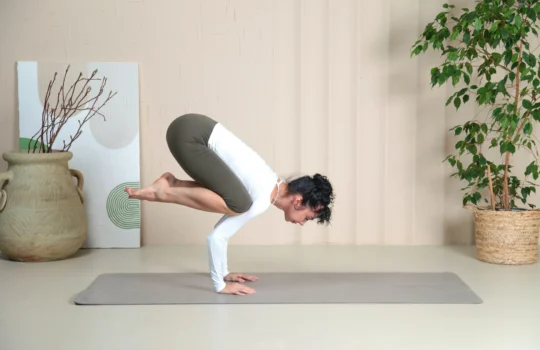Why Eco-Friendly Yoga? Practices and Products for a Sustainable Lifestyle You Need Now

In a world increasingly aware of the urgent need for environmental stewardship, the ancient practice of yoga offers more than just personal tranquility and physical health—it embodies the principle of harmony with nature. Yoga teaches us balance, not only within ourselves but with the world around us. As practitioners, we have a unique opportunity to extend the mindfulness learned on the mat to our environmental footprint. This concept of eco-friendly yoga marries the discipline’s core philosophies, such as Ahimsa (non-violence), with actions that protect and respect our planet.
Table of Contents
Eco-friendly yoga isn’t just about making greener choices; it’s a holistic approach that encompasses how we practice, the products we use, and the businesses we support. In embracing this approach, we contribute to a sustainable lifestyle that benefits both our personal well-being and the health of our planet.
This post aims to explore practical ways to incorporate sustainability into our yoga practice—from choosing eco-conscious gear to adopting practices that reduce our environmental impact. Whether you’re a seasoned yogi or new to the practice, you’ll find actionable steps to make your yoga journey more environmentally friendly. Join us as we delve into the world of eco-friendly yoga, where each choice can be an expression of gratitude and respect for the Earth that sustains us.

Understanding Eco-Friendly Yoga
Eco-friendly yoga is more than a trend; it’s a conscious effort to integrate environmental stewardship into the practice of yoga. This approach is about minimizing our ecological footprint, from the way we manage our yoga spaces to the products we choose and how we engage with our community. But why does this matter in yoga, a practice deeply personal and often focused on internal growth? The answer lies in the very foundation of yoga philosophy.
The Roots in Yoga Philosophy
Yoga’s ancient texts, like the Yoga Sutras of Patanjali, teach us the principles of Yamas and Niyamas—ethical guidelines that offer a blueprint for living a meaningful and purposeful life. Among these, Ahimsa (non-violence or non-harming) is particularly relevant to eco-friendly yoga. Ahimsa encourages us to live in a way that causes the least harm to ourselves and the world around us. This principle naturally extends to the environment, urging us to adopt practices that protect and preserve nature.
Another concept, Aparigraha (non-possessiveness or non-greed), teaches us to take only what we need, highlighting the importance of simplicity and minimalism. In the context of eco-friendly yoga, it inspires us to choose products that are sustainable and to avoid contributing to the cycle of consumerism and waste.
The Environmental Impact of Yoga
As yoga’s popularity has soared, so has the market for yoga-related products. Unfortunately, this growth has also led to increased waste and environmental degradation, from the production of non-biodegradable yoga mats to the water and energy used in manufacturing yoga apparel. Recognizing this, eco-friendly yoga seeks to make conscious choices that align with environmental sustainability, such as selecting eco-friendly materials and supporting ethical brands.
The Benefits of Eco-Friendly Yoga
Adopting an eco-friendly yoga practice isn’t just beneficial for the planet—it can enhance your personal practice by fostering a deeper connection to nature and the principles of yoga. It encourages mindfulness, not only in how we move and breathe but in how our actions impact the world. This mindfulness can lead to a more fulfilling and authentic practice, one that embodies the true essence of yoga.

Eco-Friendly Yoga Practices
Adopting an eco-friendly yoga practice involves more than just purchasing green products; it’s about integrating sustainable habits into every aspect of your yoga journey. Here are some key practices that can help reduce your environmental impact while enriching your yoga experience.
Practice Outdoors
One of the simplest ways to embrace eco-friendly yoga is to take your practice outside. Practicing yoga in natural settings not only reduces the need for artificial lighting and air conditioning but also helps you reconnect with the earth, air, and sun. Whether it’s a serene park, your backyard, or a quiet beach, outdoor yoga sessions can deepen your connection to the environment and enhance your mindfulness.
Mindful Energy Use
For those times when indoor practice is necessary, being mindful of energy use can significantly reduce your environmental footprint. Opt for natural light whenever possible by practicing near windows during the daytime. For early morning or evening sessions, use energy-efficient LED lighting. Additionally, consider the temperature of your practice space; instead of relying heavily on heating or air conditioning, dress in layers to adjust to your body’s changing temperature during practice.
Community Clean-Ups
Engaging in community clean-up events is a powerful way to practice Karma Yoga (the yoga of selfless service) while contributing to the well-being of the planet. Organize or participate in local efforts to clean up parks, beaches, or other natural spaces. This not only helps the environment but also fosters a sense of community and collective responsibility among local yogis.
Sustainable Yoga Spaces
Creating an eco-friendly yoga space, whether at home or in a studio, can have a significant impact. Use non-toxic, biodegradable cleaning products to maintain a clean and safe environment. Decorate your space with plants to improve air quality and add a touch of nature. For studios, implementing a recycling program and encouraging the use of reusable water bottles and towels can further minimize waste.
Digital Detox
Incorporate a digital detox into your yoga practice by reducing the use of electronic devices. This can mean practicing without music, using a traditional timer instead of a phone app, or even keeping your practice space free from screens. A digital detox helps reduce electricity consumption and allows for a more introspective and undistracted practice.

Section 3: Sustainable Yoga Gear and Products
The yoga industry has seen a surge in products designed to enhance practice. However, this growth often comes at an environmental cost. By choosing sustainable yoga gear, we can support the health of our planet while still enjoying the benefits of our practice. Here are some considerations and recommendations for eco-friendly yoga products.
Eco-Friendly Yoga Mats
The cornerstone of any yoga practice is the mat. Traditional mats can be made from materials harmful to the environment. Opt for mats made from natural rubber, jute, or cork. These materials are not only sustainable but also provide excellent grip and comfort. Brands like Manduka and Jade Yoga offer eco-friendly mats with great durability and performance.
Sustainable Yoga Wear
What we wear during practice also matters. Look for yoga clothing made from organic cotton, bamboo, or recycled materials. These fabrics are not only better for the environment but often offer superior breathability and comfort. Companies like Prana and Patagonia are known for their commitment to sustainability and ethical production practices.
Accessories and Props
Yoga blocks, straps, and bolsters enhance practice but can also be sources of environmental concern if made from synthetic materials. Seek out products made from natural or recycled materials. For example, blocks can be found in bamboo or cork, and straps made of cotton or hemp. Even bolsters can be eco-friendly, filled with organic cotton or buckwheat hulls instead of synthetic fillers.
Eco-Conscious Cleaning Products
Keeping your yoga gear clean is essential, but many cleaning products contain chemicals that can harm the environment. Choose or make your own cleaning solutions with natural ingredients like vinegar, essential oils, and water. Not only are these options more eco-friendly, but they can also be more economical and gentle on your gear.
Supporting Small and Local Businesses
Whenever possible, support small and local businesses that produce yoga-related products. These businesses often have a smaller carbon footprint compared to larger corporations and may use locally sourced, sustainable materials. Plus, buying local helps strengthen your community’s economy.

Section 4: Supporting Eco-Conscious Yoga Brands
Choosing eco-friendly yoga products is a significant step toward a sustainable practice, but equally important is supporting brands that prioritize environmental stewardship and ethical practices. Here’s how you can ensure your purchases support eco-conscious yoga brands.
Research Brands’ Commitments
Before purchasing, take the time to research a brand’s commitment to sustainability. Look for information on their websites about sourcing materials, manufacturing processes, and any eco-friendly certifications (such as OEKO-TEX® or GOTS for textiles). Brands that are transparent about their practices and actively working towards reducing their environmental impact are more likely to align with your values.
Eco-Friendly Yoga Clothing Brands
- Manduka emerges as a lifestyle and yoga brand with a singular aim: to deliver both stylish and eco-conscious yoga wear and accessories. Embracing organic cotton and other sustainable resources, Manduka pledges to uphold Fair Trade practices as much as possible in their production processes.
- Ibex, located in White River Junction, Vermont, similarly champions sustainable materials and low-impact dyes in their yoga wear, backed by a commitment to Fair Trade practices, ensuring their workforce is fairly compensated and works in safe conditions.
- Boody, based in Byron Bay, Australia, Boody is a yoga apparel brand that prioritizes sustainability, utilizing organic bamboo fibers renowned for their softness and absorbency. Bamboo’s sustainability credentials are complemented by Boody’s use of environmentally-friendly dyes, minimizing their ecological footprint.
- Adidas, with its headquarters in Herzogenaurach, Germany, joins the ranks of yoga apparel brands committed to sustainability through the use of organic cotton and recycled polyester, along with low-impact dyes and Fair Trade practices.
- Alo Yoga, beyond Yoga in Los Angeles, California, also based in Los Angeles, mirror these sustainable and ethical practices with their eco-conscious materials, low-impact dyes, and adherence to Fair Trade standards, ensuring their workers receive fair wages and work in safe environments.
- Patagonia stands out as a prominent name in sustainable yoga wear, employing organic cotton and recycled materials in their product line. The brand’s dedication to Fair Trade ensures equitable wages for their workers, showcasing their commitment to ethical practices.
- Lululemon has also prioritized sustainability, offering a range of yoga apparel and accessories crafted from organic cotton and recycled polyester, demonstrating their commitment to environmental stewardship.
- ecoYoga sets itself apart with yoga mats crafted from 100% natural rubber and jute fiber, pioneering environmentally neutral products that lead in sustainability.
- Gaiam focuses on producing eco-friendly yoga gear, utilizing organic cotton and bamboo in their apparel and accessories. Their commitment extends to Fair Trade practices, ensuring fair compensation for their workers.
- Yoga Democracy, hailing from Los Angeles, California, prides itself on using sustainable materials like organic cotton and recycled polyester, complemented by eco-friendly dyes. Their Fair Trade certification guarantees fair wages and safe conditions for their workers, with their yoga pants being notably comfortable and well-fitting.
- prAna, from Carlsbad, California, creates yoga apparel from sustainable sources such as organic cotton and recycled polyester. They also use eco-conscious dyes and maintain Fair Trade certification to ensure ethical treatment and pay for their workers.
Look for Certifications and Seals of Approval
Certifications can be a helpful guide to understanding a brand’s environmental and ethical commitments. Look for certifications like Fair Trade, which ensures fair labor practices, or the Global Recycled Standard for products made from recycled materials. These certifications indicate that a brand is held to specific standards regarding its environmental and social impact.
Support Brands That Give Back
Many eco-conscious brands go beyond minimizing harm by actively contributing to environmental or social causes. Whether it’s planting a tree for every product sold, donating a percentage of profits to conservation efforts, or supporting communities in need, these initiatives show a brand’s commitment to making a positive impact. Choosing to support these brands helps extend the reach of your own eco-friendly efforts.
Encourage Transparency and Sustainability
As consumers, we have the power to demand more from the companies we support. Encouraging transparency about where and how products are made can push more brands to consider their environmental impact and adopt sustainable practices. Whenever possible, engage with brands through social media or customer feedback channels to express your appreciation for their eco-friendly efforts or to encourage more sustainable practices.
Spread the Word
When you find a yoga brand that truly embodies eco-conscious principles, share your discovery with your community. Whether it’s through social media, word of mouth, or reviews, spreading the word about sustainable brands can increase their visibility and influence others to make more environmentally friendly choices. Your endorsement can help grow the market for sustainable yoga products, encouraging more brands to adopt eco-friendly practices.

Section 5: DIY Yoga Products
Embracing a DIY approach to yoga products not only helps the environment by reducing consumption and waste but also adds a personal touch to your practice. Here are some simple DIY projects to enhance your yoga experience sustainably.
Homemade Yoga Mat Cleaner
Keeping your yoga mat clean is essential, but commercial cleaners often contain harsh chemicals. You can make an effective and natural mat cleaner with ingredients like:
- 1 part white vinegar
- 3 parts water
- A few drops of essential oil (such as lavender or tea tree for their antimicrobial properties)
Mix these in a spray bottle, and you have a yoga mat cleaner that’s both eco-friendly and pleasant-smelling. Shake well before each use, spray on your mat, and wipe down with a cloth.
DIY Yoga Blocks
While buying eco-friendly yoga blocks made from cork or bamboo is a great option, you can also repurpose household items. For example, sturdy books wrapped in fabric can serve as temporary blocks, or you can craft your own from reclaimed wood, ensuring you sand the edges smooth to avoid splinters.
Sew Your Own Yoga Bolster
Creating a yoga bolster allows for customization in size, firmness, and fabric. Use durable, natural fabrics like cotton or linen and fill your bolster with materials like organic cotton batting, buckwheat hulls, or even old clothes for a more sustainable choice. Sewing your own bolster can be a rewarding project that results in a personalized and eco-friendly yoga prop.
Knit or Crochet Yoga Socks and Gloves
For those who enjoy knitting or crocheting, creating your own yoga socks and gloves can be a fun project. Use natural fibers like wool or bamboo yarn to ensure breathability and grip. These handmade items can improve your practice on cold days or on slippery mats and make thoughtful gifts for fellow yogis.
Upcycling for Yoga Accessories
Look around your home for items that can be repurposed into yoga accessories. Old belts can become yoga straps, and blankets can serve as substitutes for yoga towels or blankets in restorative poses. Upcycling not only saves money but also aligns with the principles of sustainability by giving new life to items that might otherwise be discarded.

Section 6: Incorporating Eco-Friendliness into Yoga Teaching and Studios
For yoga teachers and studio owners, promoting sustainability can significantly impact both the community and the environment. Here are ways to foster eco-friendliness in your teaching and studio operations:
Green Studio Practices
- Energy Efficiency: Utilize natural lighting as much as possible and opt for energy-efficient LED bulbs. Consider installing timers or motion sensors to reduce energy waste.
- Sustainable Materials: Use eco-friendly materials for studio flooring, like bamboo or recycled rubber, and decorate with non-toxic paints and sustainable decor.
- Waste Reduction: Implement recycling programs, offer filtered water stations to discourage single-use plastic bottles, and encourage the use of reusable mats and props.
Eco-Friendly Classes and Workshops
- Offer classes that focus on the principles of sustainability and how they intertwine with yoga philosophy. Workshops on making DIY yoga products or living a minimalistic lifestyle can empower your students to make greener choices.
- Host outdoor yoga sessions or events that benefit environmental causes, strengthening the community’s connection to nature and its commitment to preservation.
Support for Eco-Conscious Choices
- Provide incentives for students who make sustainable choices, such as discounts for those who bike to class or bring their own mats and props.
- Curate a selection of eco-friendly yoga products for sale or use in your studio, ensuring students have access to sustainable options.
Conclusion
Eco-friendly yoga is about much more than personal well-being; it’s a holistic approach that encompasses our environmental footprint, the products we use, and the communities we build. By integrating sustainability into our practice, we honor yoga’s foundational principles of mindfulness, respect, and non-harm. From choosing sustainable gear and supporting eco-conscious brands to embracing DIY projects and green studio practices, every action we take is a step toward a more sustainable and mindful existence.
Share Your Journey
Now is the time to bring the principles of eco-friendly yoga into our lives and practices. Start with one small change today—whether it’s swapping to a natural rubber mat, attending a clean-up event, or simply practicing yoga under the open sky. Share your journey towards a more sustainable practice with friends, family, and fellow yogis, and encourage them to join you in making mindful choices that benefit our planet.
Let’s commit to making eco-friendly yoga not just a part of our routine but a part of our ethos. Together, we can create a ripple effect that encourages a more sustainable and compassionate world. What step will you take today to make your yoga practice more eco-friendly?
For more insightful yoga blogs:






